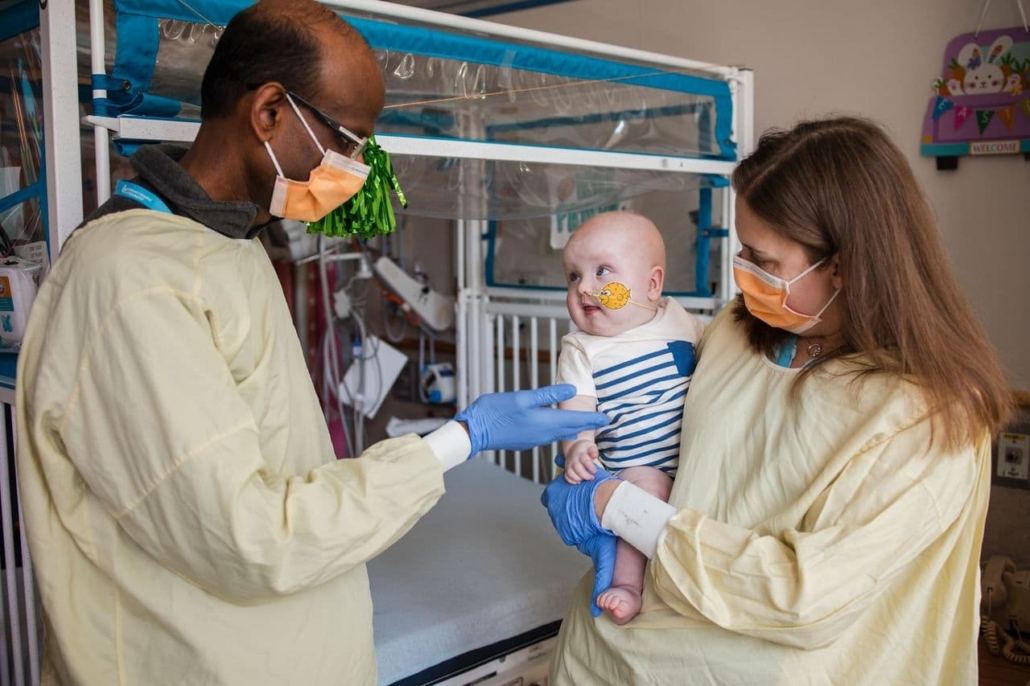World’s first personalised CRISPR therapy treats child with rare metabolic disorder
Researchers at Children’s Hospital of Philadelphia and Penn Medicine have successfully treated an infant with a rare genetic disease using a bespoke CRISPR gene editing therapy, marking a watershed moment in personalised genomic medicine.

Drs. Kiran Musunuru and Rebecca Ahrens-Nicklas with patient KJ.
© Children’s Hospital of Philadelphia
In a historic medical advancement, physicians at Children’s Hospital of Philadelphia (CHOP) and Penn Medicine have successfully treated a patient with a personalised CRISPR gene editing therapy – the first of its kind in the world. The landmark case, published in The New England Journal of Medicine on 15 May 2025, demonstrates how customised gene editing technology can be effectively deployed to treat rare genetic disorders that previously had limited treatment options.
Pioneering personalised genomic medicine
The patient, identified as KJ, was diagnosed with severe carbamoyl phosphate synthetase 1 (CPS1) deficiency, a rare metabolic disorder that impairs the body’s ability to process ammonia – a byproduct of protein metabolism. Without proper enzymatic function, ammonia accumulates to toxic levels, potentially causing severe brain and liver damage.
After spending the first several months of his life in hospital on a very restrictive diet, KJ received his first dose of bespoke therapy in February 2025 at between six and seven months of age.
“Years and years of progress in gene editing and collaboration between researchers and clinicians made this moment possible, and while KJ is just one patient, we hope he is the first of many to benefit from a methodology that can be scaled to fit an individual patient’s needs,” said Dr Rebecca Ahrens-Nicklas, director of the Gene Therapy for Inherited Metabolic Disorders Frontier Program at CHOP and assistant professor of Pediatrics at the University of Pennsylvania.
From concept to treatment in six months
The collaborative research team, led by Dr Ahrens-Nicklas and Dr Kiran Musunuru of Penn Medicine, focused specifically on urea cycle disorders, of which CPS1 deficiency is a particularly severe form.
Within six months of identifying KJ’s specific genetic variant, the team designed and manufactured a base editing therapy delivered via lipid nanoparticles to the liver to correct his faulty enzyme. This rapid timeline from diagnosis to experimental treatment represents a remarkable achievement in translational medicine.
KJ received his first infusion in late February 2025, with follow-up doses in March and April. The researchers documented their findings in the newly published paper, describing the rigorous yet expedited development process that made this personalised treatment possible.
Early promising results
As of April 2025, KJ had received three doses of the therapy with no serious side effects. In the short time since treatment, he has tolerated increased dietary protein and needed less nitrogen scavenger medication. He has also been able to recover from typical childhood illnesses like rhinovirus without ammonia building up in his body.
“While KJ will need to be monitored carefully for the rest of his life, our initial findings are quite promising,” said Dr Ahrens-Nicklas.
The standard treatment for CPS1 deficiency typically involves liver transplantation. However, transplants require patients to be medically stable and sufficiently developed to withstand such a major procedure – leaving young patients vulnerable to potentially fatal ammonia spikes during the waiting period.
Beyond one-size-fits-all gene editing
Traditional gene therapy approaches have primarily targeted more common diseases affecting larger populations. The FDA has approved CRISPR-based therapies for sickle cell disease and beta thalassemia, but the vast majority of rare genetic disorders – which collectively affect millions worldwide – have remained without targeted treatments.
This landmark finding could provide a pathway for gene editing technology to be successfully adapted to treat individuals with rare diseases for whom no medical treatments are available.
“We want each and every patient to have the potential to experience the same results we saw in this first patient, and we hope that other academic investigators will replicate this method for many rare diseases and give many patients a fair shot at living a healthy life,” Dr Musunuru said. “The promise of gene therapy that we’ve heard about for decades is coming to fruition, and it’s going to utterly transform the way we approach medicine.”
Family impact
KJ’s parents, Nicole and Kyle Muldoon, expressed both hope and relief regarding their son’s treatment.
“We would do anything for our kids, so with KJ, we wanted to figure out how we were going to support him and how we were going to get him to the point where he can do all the things a normal kid should be able to do,” Nicole Muldoon said. “We thought it was our responsibility to help our child, so when the doctors came to us with their idea, we put our trust in them in the hopes that it could help not just KJ but other families in our position.”
The research received support from the National Institutes of Health Somatic Cell Genome Editing Program and additional NIH grants, with in-kind contributions from several biotechnology companies.
Reference
Musunuru, K., et al. (2025). Patient-Specific In Vivo Gene Editing to Treat a Rare Genetic Disease. New England Journal of Medicine. https://doi.org/10.1056/NEJMoa2504747

